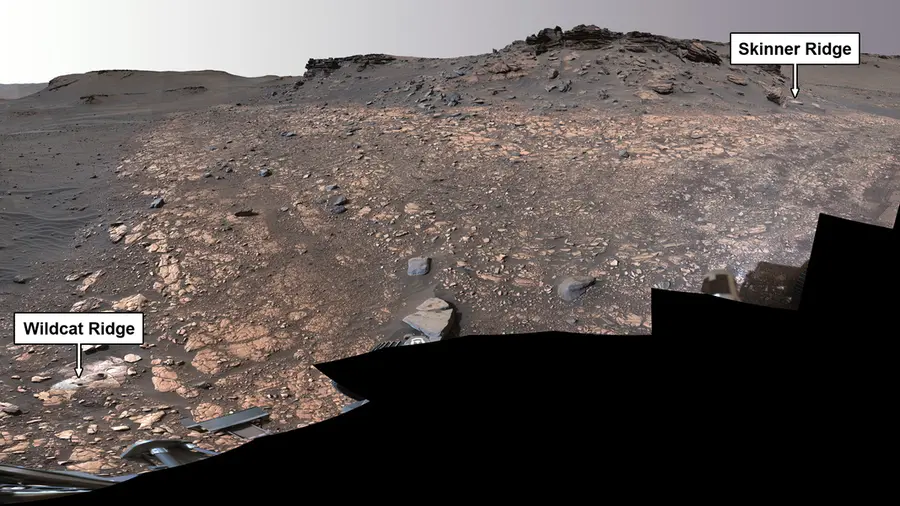In a new study published in the journal AGU Advances, scientists from MIT and NASA reveal that seven rock samples, gathered along the “fan front” of Mars’ Jezero Crater, contain minerals typically formed in water. This discovery strongly suggests that these rocks were either deposited by water or formed in its presence.
NASA’s Perseverance rover collected these seven samples in 2022 while exploring the crater’s western slope. This area, resembling a fan-like region, contains sedimentary, layered rocks, leading scientists to believe it was once an ancient delta. This delta, they hypothesize, formed as sediment flowed from a river into a now-dry lakebed. The Perseverance science team, including MIT scientists, meticulously studied the rover’s images and chemical analyses of the samples. Their findings confirmed the presence of water indicators within the rocks, supporting the theory that the crater was once a watery, habitable environment.
While the question of whether the crater actually hosted life remains unanswered, the team’s analysis couldn’t confirm the presence of organic matter – the building blocks of life – based on the rover’s current capabilities. However, the mineral content of the rocks makes them prime candidates for finding signs of ancient Martian life once they are returned to Earth for more advanced analysis.
“These rocks confirm the presence, at least temporarily, of habitable environments on Mars,” says Tanja Bosak, the study’s lead author and a professor of geobiology in MIT’s Department of Earth, Atmospheric and Planetary Sciences (EAPS). “What we’ve found is that indeed there was a lot of water activity. For how long, we don’t know, but certainly for long enough to create these big sedimentary deposits.”
Adding to the intrigue, some of the collected samples may have been deposited in the ancient lake over 3.5 billion years ago – predating even the earliest signs of life on Earth.
“These are the oldest rocks that may have been deposited by water, that we’ve ever laid hands or rover arms on,” says co-author Benjamin Weiss, the Robert R. Shrock Professor of Earth and Planetary Sciences at MIT. “That’s exciting, because it means these are the most promising rocks that may have preserved fossils, and signatures of life.”

The study involved several MIT researchers, including postdoc Eva Scheller, research scientist Elias Mansbach, and other members of the Perseverance science team.
The 2022 sample collection was part of the rover’s Fan Front Campaign, focusing on the crater’s western slope where the fan-like region exists. Scientists believe this area holds the highest potential for preserving signs of ancient Martian life within its sedimentary layers. Perseverance collected the samples by drilling into the Martian bedrock, extracting pencil-sized cores, and sealing them in tubes for eventual return to Earth. Before extraction, the rover captured images of the surrounding sediments at each location. The science team then analyzed this imaging data to estimate the sediment’s average grain size and mineral composition. This analysis revealed that all seven samples likely contain signs of water, suggesting their initial deposition by water.
Bosak and her colleagues specifically identified minerals known to precipitate out of water. “We found lots of minerals like carbonates, which are what make reefs on Earth,” Bosak says. “And it’s really an ideal material that can preserve fossils of microbial life.”
Intriguingly, sulfates were also found in some samples collected at the base of the fan front. These minerals form in very salty water, further supporting the existence of water in the crater. However, Bosak notes that very salty water “is not necessarily the best thing for life.” If the entire crater was once filled with highly saline water, life would have struggled to thrive. However, a briny bottom layer could have preserved any signs of life that existed in less salty layers above and eventually drifted down.
“However salty it was, if there were any organics present, it’s like pickling something in salt,” Bosak explains. “If there was life that fell into the salty layer, it would be very well-preserved.”
Despite these promising findings, the team emphasizes that organic matter hasn’t been definitively detected by the rover’s instruments. While organic matter can indicate life, it can also result from geological processes unrelated to living organisms. Previous observations by Perseverance’s SHERLOC instrument, which uses ultraviolet light to scan for organics, showed potential signs on the crater floor and later along the fan front. However, careful analysis led by MIT’s Eva Scheller revealed that these signals could also originate from non-organic substances.
“It turns out that cerium metals incorporated in minerals actually produce very similar signals as the organic matter,” Scheller explains. “When investigated, the potential organic signals were strongly correlated with phosphate minerals, which always contain some cerium.”
While Scheller’s work highlights the need for caution in interpreting the rover’s measurements, it doesn’t rule out the presence of organic matter.“
This is not bad news,” Bosak reassures. “It just tells us there is not very abundant organic matter. It’s still possible that it’s there. It’s just below the rover’s detection limit.”
Once the collected samples are returned to Earth, laboratory instruments with greater sensitivity will be able to definitively determine the presence of any organic matter.
“On Earth, once we have microscopes with nanometer-scale resolution and various types of instruments that we cannot staff on one rover, then we can actually attempt to look for life,” Bosak concludes.
This research was supported in part by NASA.













Responses (0 )